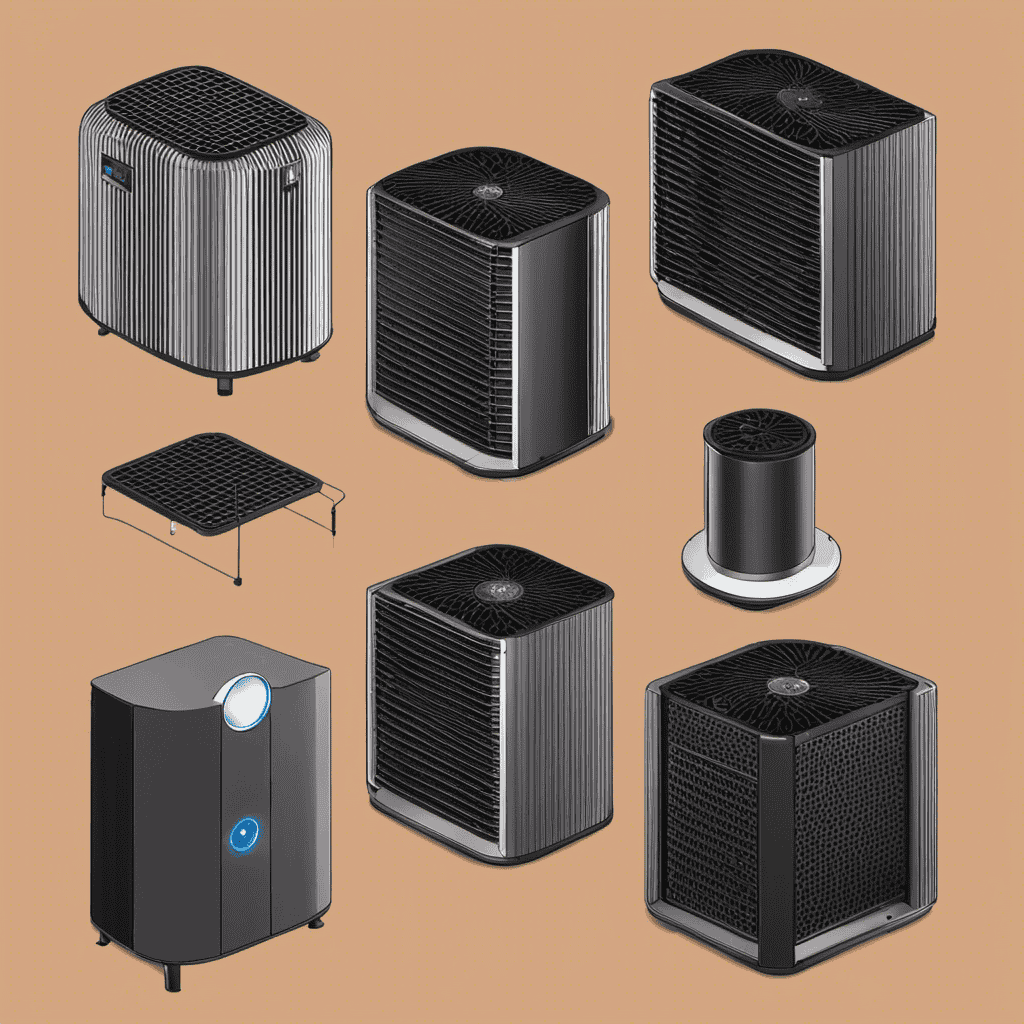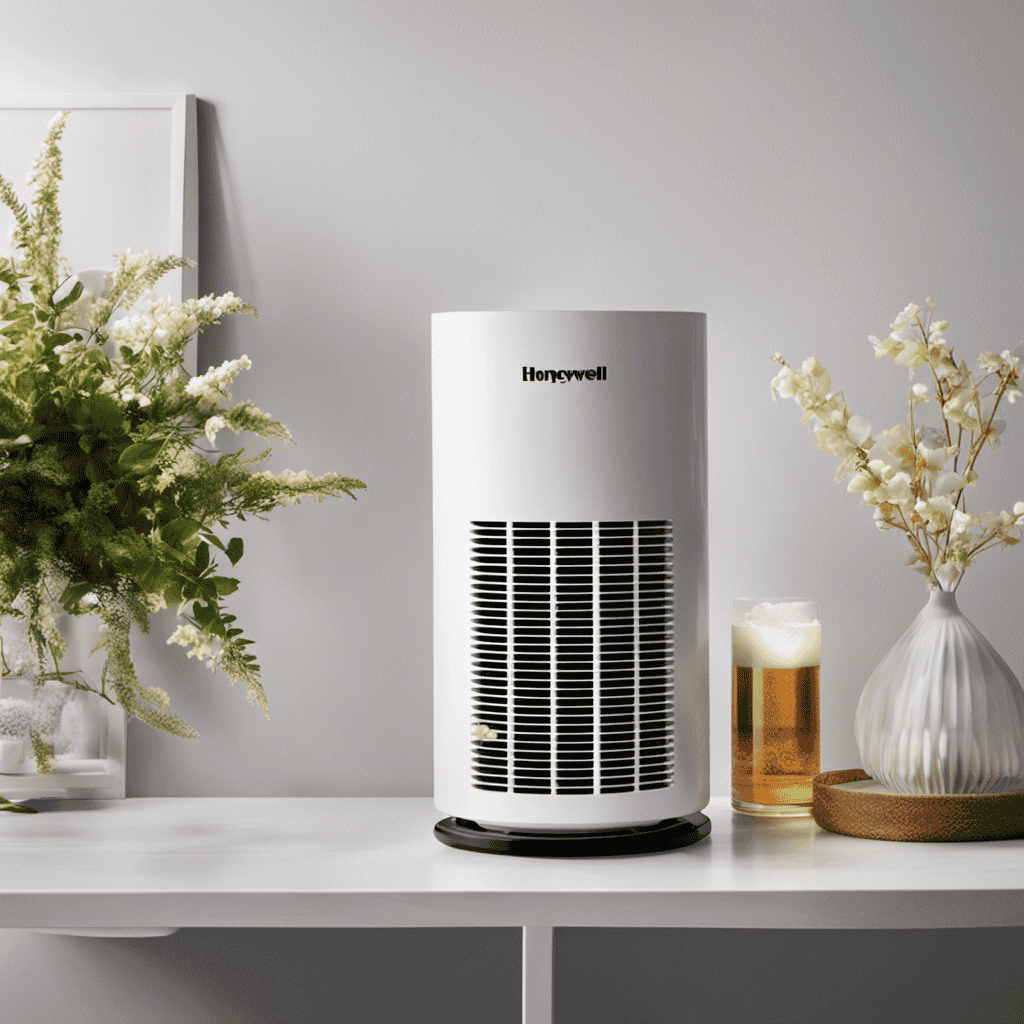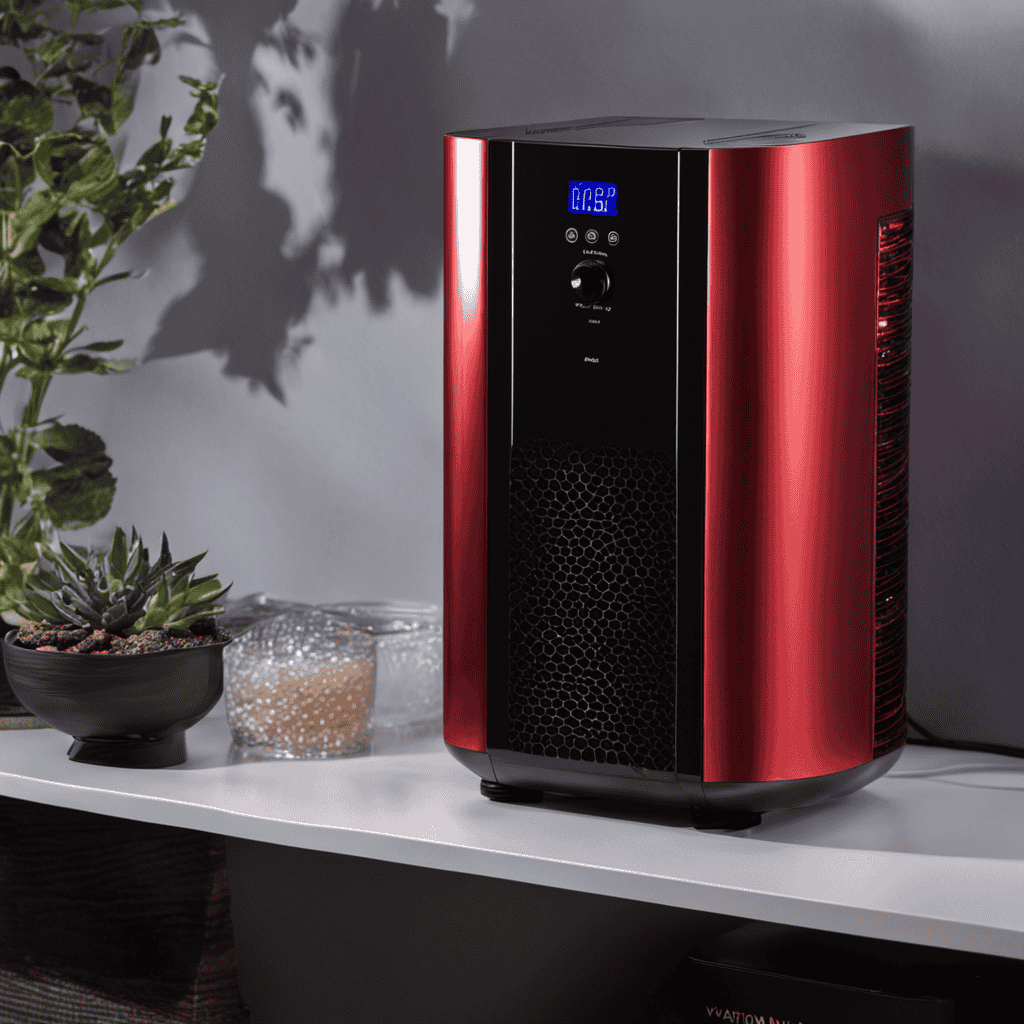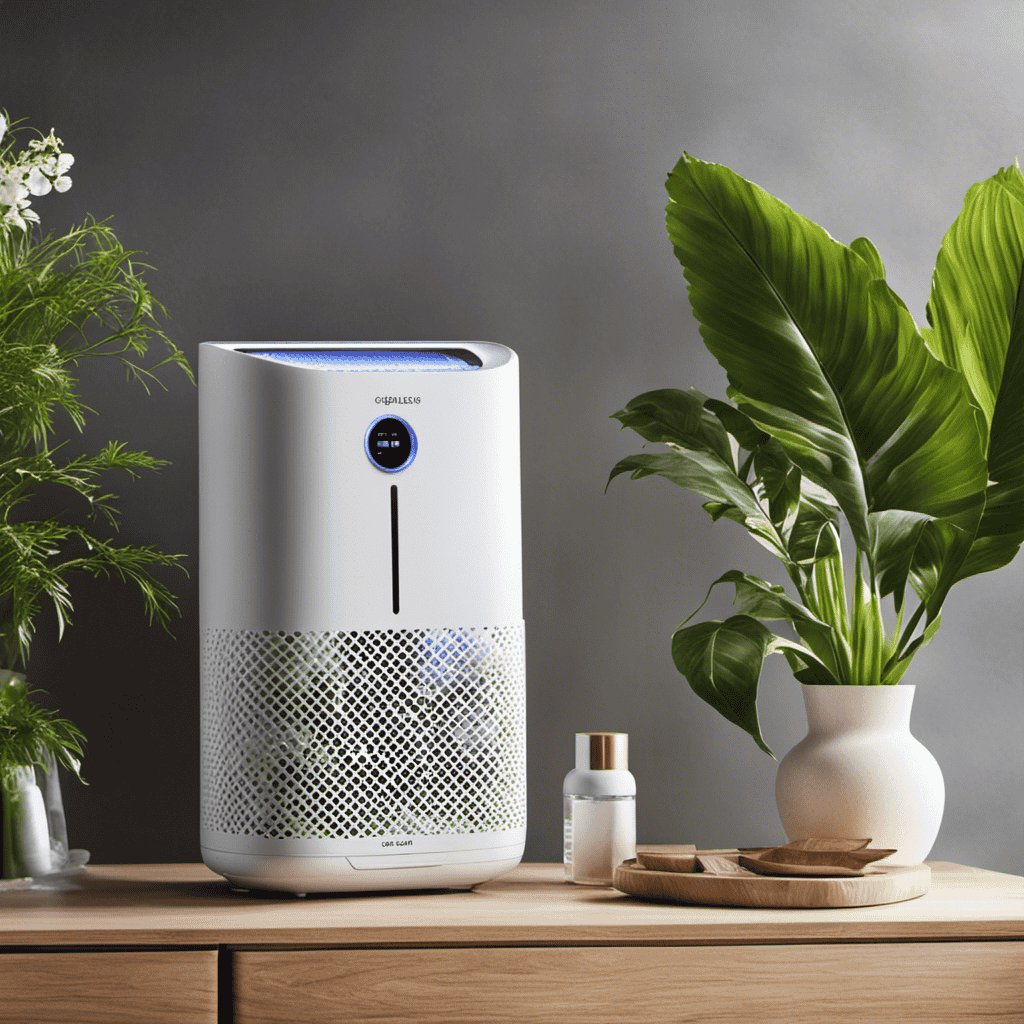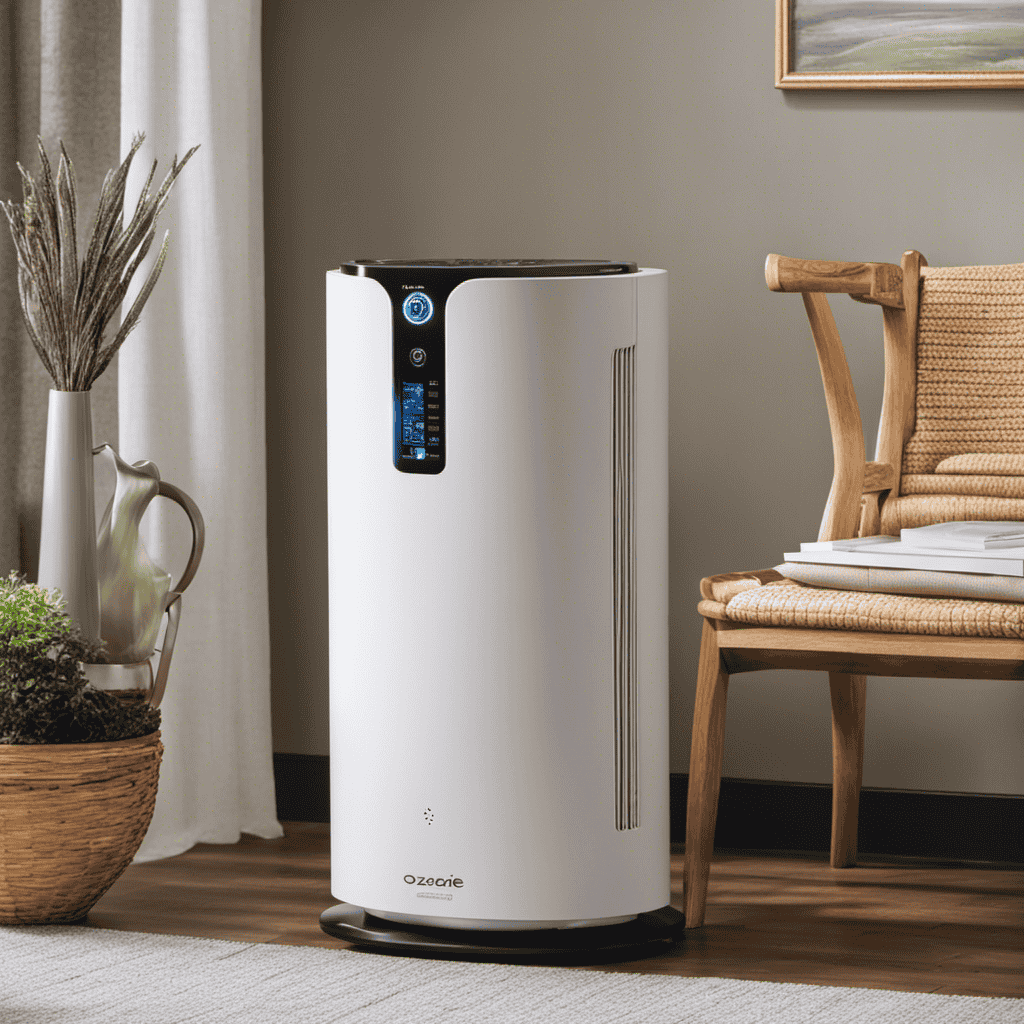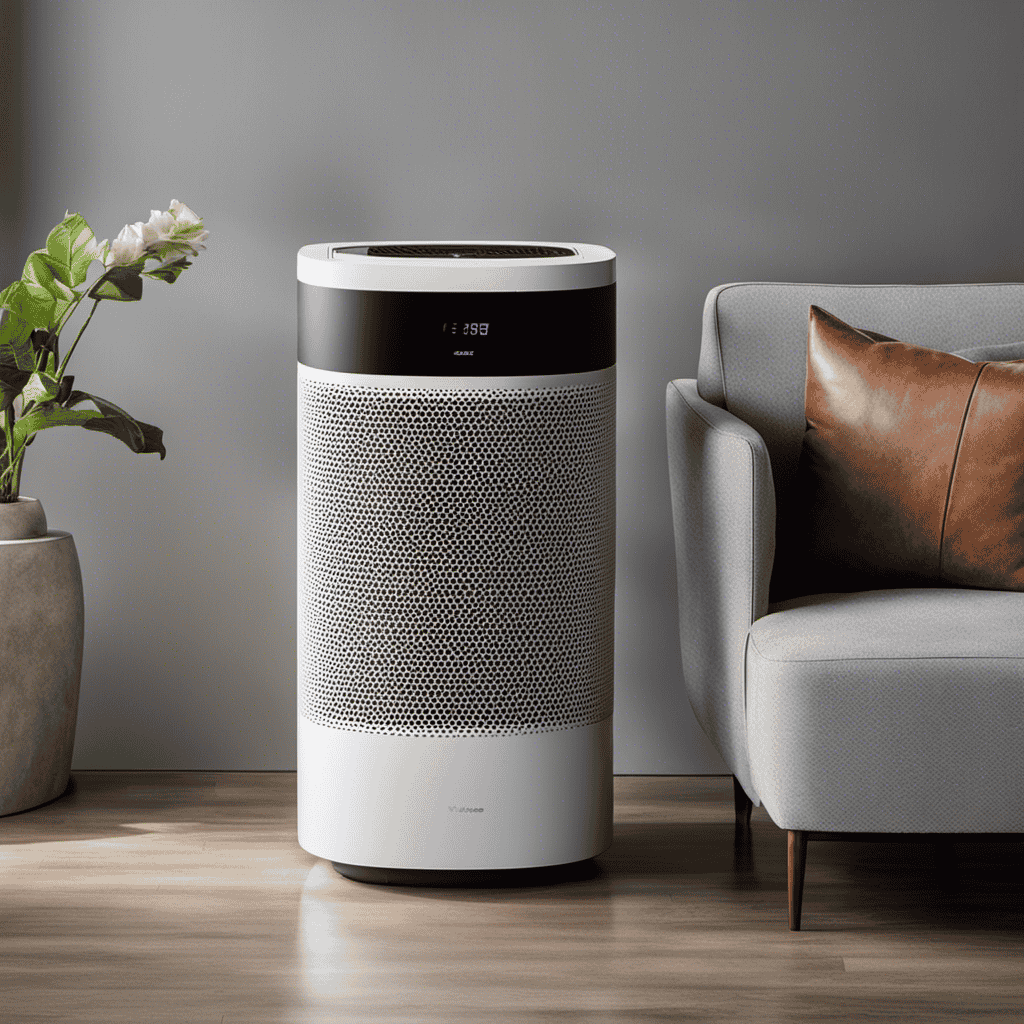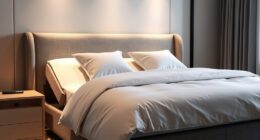I have always been worried about the air quality in my home, which is why I took it upon myself to build an air purifier.
In this article, I’ll guide you through the step-by-step process of creating your own air purifier using readily available materials and tools.
By the end, you’ll have a custom-made device that will help improve the air quality in your living space.
Let’s get started!
Key Takeaways
- Optimal filter size and high MERV rating are crucial for effective air purification.
- Different filtering methods like HEPA filters, activated carbon filters, and ionizers can be used.
- Regular maintenance and cleaning are important for maximizing air purification benefits.
- Proper installation and secure attachment of the filter ensure effective filtration and improved indoor air quality.
Choosing the Right Materials
When building an air purifier, it’s important to choose the right materials. The optimal filter size is crucial for ensuring effective air purification. For a DIY air purifier, selecting the appropriate filter size is essential to maintain optimal airflow and filtration efficiency.
The filter should be large enough to capture a wide range of airborne particles, including dust, pollen, and pet dander. Additionally, it should have a high MERV (Minimum Efficiency Reporting Value) rating to effectively remove contaminants from the air. By using the right filter size, you can ensure that your DIY air purifier efficiently cleans the air in your space.
Understanding the importance of materials in air purification leads us to the next section, where we explore air purification technology in more detail.
Understanding Air Purification Technology
To understand how air purification technology works, you need to familiarize yourself with the different filtering methods. Air purifiers are designed to remove pollutants and improve indoor air quality.
There are several types of filters commonly used in air purifiers, including HEPA filters, activated carbon filters, and ionizers. HEPA filters are highly effective at capturing particles as small as 0.3 microns, while activated carbon filters are great for removing odors and chemicals. Ionizers work by releasing negatively charged ions that attach to airborne particles, causing them to fall out of the air.
When choosing an air purifier, it’s important to consider the size of the room and the specific air quality indicators you want to target. Understanding the different filtering methods will help you select the most effective air purifier for your needs.
Now, let’s move on to gathering the necessary tools for building your own air purifier.
Gathering the Necessary Tools
First, make sure you have all the necessary tools for assembling your own air purification system. It’s important to have the right equipment to ensure a successful and efficient build. Here are three essential tools you’ll need:
-
Screwdriver: You’ll need a screwdriver to secure the different components of the air purifier together. Make sure you have a variety of screwdriver sizes to accommodate different screws.
-
Wire cutters: Wire cutters are necessary for cutting and stripping wires during the assembly process. They’ll help you connect the various electrical components of the air purifier.
-
Pliers: Pliers are useful for gripping and manipulating small parts. They can come in handy when attaching filters or adjusting components.
By having these tools readily available, you can ensure a smooth assembly process for your air purification system.
Regular maintenance and cleaning will also help maximize the air purification benefits and keep your air purifier running efficiently.
Building the Air Filter Housing
Make sure you have all the necessary components before assembling the filter housing for your DIY air purification system. The first step is choosing the right filter material. The effectiveness of your air purifier largely depends on the filter material you select. Look for filters that can trap small particles like dust, pollen, and pet dander.
Once you have the filter material, it’s time to secure it in the housing. Start by placing the filter in the housing and making sure it fits snugly. Then, use the provided clips or screws to secure the filter in place. This will prevent any air leaks and ensure that all the air passing through the housing is properly filtered.
Now that the filter is securely in the housing, let’s move on to installing the air filter.
Installing the Air Filter
Once the filter is secured in the housing, you’ll need to locate the designated slot for installing the air filter. This step is crucial for ensuring proper airflow and filtration in your air purifier.
Here are some air filter installation tips and troubleshooting techniques to help you along the way:
- Make sure the filter is oriented correctly, with the airflow arrow pointing towards the fan.
- Gently slide the filter into the slot, ensuring a snug fit without forcing it.
- Double-check that the filter is securely in place before closing the housing.
Proper installation of the air filter is essential for the effective functioning of your air purifier. It ensures that the air passing through the system is properly filtered, removing contaminants and improving indoor air quality.
Now that the air filter is installed, let’s move on to wiring the fan and power supply.
Wiring the Fan and Power Supply
When it comes to wiring the fan and power supply in your air purifier, there are a few key tips to keep in mind.
First, make sure to properly connect the fan wires to the power supply, ensuring a secure and reliable connection.
Additionally, it is important to double-check the polarity of the power supply connections to avoid any potential damage or malfunctions.
Fan Wiring Tips
One important tip for fan wiring is to ensure that all the connections are secure. Loose connections can lead to poor performance and even potential hazards.
When it comes to fan maintenance and noise reduction techniques, here are three key things to keep in mind:
-
Use rubber grommets or vibration isolators: These help to minimize vibrations and reduce noise caused by the fan’s operation. By isolating the fan from the mounting surface, you can significantly decrease the overall noise level.
-
Check and clean the fan blades regularly: Over time, dust and debris can accumulate on the fan blades, causing imbalance and noise. Regularly inspect and clean the blades to ensure optimal performance and noise reduction.
-
Lubricate the fan motor: Proper lubrication of the fan motor can help reduce friction and noise. Refer to the manufacturer’s guidelines for the appropriate type and amount of lubricant to use.
Power Supply Connections
Make sure you securely connect the power supply to prevent any potential hazards. Power supply safety is crucial when building any electronic device, including an air purifier.
The first step is to ensure that the power supply you are using is compatible with the device’s requirements. Check the voltage and current ratings of the power supply and compare them with the specifications of your air purifier. It is essential to match these values to avoid overloading the components or causing damage.
Once you have confirmed compatibility, connect the power supply to the appropriate input terminals on your air purifier. Double-check the connections to make sure they are secure and tight.
Always follow the manufacturer’s instructions and guidelines to ensure proper power supply installation and minimize the risk of electrical accidents.
Adding the Control Panel
To add the control panel, you’ll need to attach the buttons and connect the wires correctly. The control panel is an essential component of the air purifier design as it allows users to adjust settings and monitor the device’s performance.
Here are three important steps to follow:
-
Attach the buttons: Carefully position the buttons on the control panel according to your preferred layout. Ensure they are securely fastened using screws or adhesive.
-
Connect the wires: Identify the appropriate terminals on the control panel and match them with the corresponding wires from the air purifier’s circuit board. Use connectors or soldering to establish a secure connection.
-
Test the functionality: Before closing the air purifier’s casing, test the control panel’s functionality. Make sure each button responds correctly and that the LED indicators light up as intended.
Following these steps will ensure that the control panel is properly integrated into your air purifier, allowing for easy and convenient operation.
Testing the Air Purifier
Now that the control panel of the air purifier is successfully installed, it’s time to test the effectiveness of the device.
Air quality monitoring is a crucial step in ensuring that the air purifier is working efficiently. To perform this test, I will use a specialized air quality monitor.
Placing the monitor in the room, I will activate the air purifier and let it run for a specific period. During this time, the monitor will measure various air pollutants such as particulate matter and volatile organic compounds (VOCs).
After the test period, I will analyze the data obtained from the monitor to evaluate the filter effectiveness of the air purifier. This analysis will provide valuable insights into the device’s ability to remove harmful particles and improve indoor air quality.
Enhancing Air Purification Efficiency
When it comes to enhancing air purification efficiency, two key factors to consider are optimal filter selection and air circulation techniques.
The choice of filters plays a crucial role in capturing and removing pollutants from the air, so it’s important to select filters that are designed to effectively trap specific contaminants.
Additionally, implementing proper air circulation techniques helps ensure that purified air is distributed evenly throughout the space, maximizing the effectiveness of the air purifier.
Optimal Filter Selection
Choosing the right filters is crucial for creating an effective air purifier. When selecting filters, it’s important to compare their efficiency to ensure optimal air purification. Here are three key factors to consider:
-
Filter Type: Different filters target specific pollutants, such as HEPA filters for allergens and activated carbon filters for odors and chemicals. Understanding your specific needs will help you choose the appropriate filter type.
-
Filter Efficiency: Look for filters with high efficiency ratings, indicated by their MERV (Minimum Efficiency Reporting Value) or CADR (Clean Air Delivery Rate). Higher ratings mean the filter can capture smaller particles and provide better air purification.
-
Filter Lifespan: Consider the lifespan of the filters and how often they need to be replaced. This will help you estimate the long-term cost and maintenance requirements of your air purifier.
By carefully selecting filters based on type, efficiency, and lifespan, you can ensure that your air purifier effectively removes pollutants from your indoor environment.
Now, let’s explore the next important aspect: air circulation techniques.
Air Circulation Techniques
To ensure proper circulation of clean air in your space, consider utilizing various techniques.
-
Adjust fan speeds: By adjusting the fan speeds, you can control the flow of air in the room. This ensures that the air is effectively circulated and pollutants are removed.
-
Strategically place the air purifier: Placing the air purifier in an optimal location can enhance its effectiveness in cleaning the air. Consider placing it near a source of pollutants or in a central area.
Proper air circulation is crucial for improving indoor air quality and reaping its benefits. These techniques work together to create a healthier indoor environment by removing airborne pollutants and refreshing the air.
Now, let’s move on to the next section and explore maintenance and cleaning tips for your air purifier.
Maintenance and Cleaning Tips
Make sure you regularly clean the filters of your air purifier to maintain its effectiveness. Proper cleaning techniques and filter maintenance are crucial for the optimal functioning of your device. Here are some tips to help you keep your air purifier in top condition:
-
Vacuum the pre-filter: This removes larger particles such as dust and pet hair, preventing them from clogging the main filter.
-
Wash or replace the HEPA filter: Depending on the model, you may be able to wash the filter or need to replace it. Follow the manufacturer’s instructions for the best results.
-
Clean the activated carbon filter: Gently vacuum or wipe the surface to remove any accumulated dirt and debris.
Troubleshooting and Common Issues
When it comes to troubleshooting and common issues with air purifiers, there are three key points to consider: filter replacement frequency, strange odors or smells, and power supply issues.
First, it is important to understand the recommended filter replacement frequency for your specific air purifier model. This will ensure optimal performance and maintain clean air quality in your space.
Next, if you notice any strange odors or smells coming from your air purifier, it may be a sign that the filters need to be replaced or that there is a buildup of contaminants.
Filter Replacement Frequency
You should regularly check your air purifier’s filter to ensure it is not clogged or dirty. Keeping the filter clean is crucial for maintaining the effectiveness of your air purifier.
Here are some filter replacement tips to help prolong the lifespan of your filter:
-
Vacuum the filter: Use a vacuum cleaner with a brush attachment to remove any dust or debris from the filter. This will help extend its lifespan.
-
Wash the filter: Some filters are washable, so follow the manufacturer’s instructions to clean them properly. Make sure the filter is completely dry before reinstalling it.
-
Use a pre-filter: Consider using a pre-filter to capture larger particles and prevent them from reaching the main filter. This can help reduce the frequency of filter replacements.
Strange Odors or Smells
In my previous discussion about filter replacement frequency, I emphasized the importance of maintaining a clean and efficient air purifier. Now, let’s dive into a common concern: strange odors or smells. Whether it’s the lingering scent of your furry friend or the remnants of a smoky environment, eliminating pet odors and removing smoke smells can be a challenge. Luckily, with the right approach and a well-designed air purifier, these odors can be effectively neutralized. Take a look at the table below, which showcases some effective techniques for combating these specific smells:
| Technique | Description |
|---|---|
| Activated Carbon Filters | Absorb and trap pet odors and smoke smells through a highly porous surface. |
| Ozone Generators | Release ozone molecules to neutralize odors at a molecular level. |
| Ionizers | Emit negatively charged ions to bond with odor-causing particles, eliminating smells. |
Power Supply Issues
If the strange odors persist, it’s possible that power supply issues may be affecting the effectiveness of the air purifier. The power supply is a critical component of the air purifier, providing the necessary electrical energy for it to function properly.
To ensure power supply safety and troubleshoot any issues, follow these steps:
- Check the power cord for any visible damage or loose connections.
- Test the power outlet by plugging in another device to see if it works.
- If the air purifier has a power switch, make sure it is in the ‘on’ position.
By addressing power supply issues, you can improve the performance and reliability of your air purifier.
Remember to exercise caution when handling electrical components and always prioritize power supply safety. If you are unsure about any troubleshooting steps, consult the manufacturer’s manual or seek professional assistance.
Frequently Asked Questions
What Are the Potential Health Benefits of Using an Air Purifier?
Using an air purifier can potentially provide health benefits by reducing indoor air pollutants, such as allergens, smoke, and mold spores. It can also be cost-effective in the long run by improving respiratory health and reducing potential risks.
How Long Does It Typically Take to Build an Air Purifier?
Building an air purifier can take varying amounts of time depending on the complexity of the design and the availability of components. Potential challenges and factors to consider include cost, efficiency, and compatibility with existing systems.
Can I Customize the Design of the Air Filter Housing?
Yes, you can customize the design of the air filter housing. This allows you to tailor the air purifier to your specific needs and preferences, ensuring optimal performance and aesthetic appeal.
Is It Possible to Use Alternative Power Sources for the Fan and Power Supply?
Yes, it is possible to use alternative power sources such as solar energy or battery power for the fan and power supply. This allows for greater flexibility and sustainability in the operation of the air purifier.
Are There Any Specific Cleaning Products or Methods Recommended for Maintaining the Air Purifier?
For the air purifier’s maintenance, it is crucial to use suitable cleaning products and methods. Regularly clean the filters with a mild detergent solution and ensure proper drying. Follow the manufacturer’s instructions for optimal maintenance.
Can I Use the DIY Air Purifier Method to Achieve the Same Results as a Store-Bought Air Purifier?
Yes, you can purify air without air purifier using the DIY method. By using household items like baking soda, vinegar, and essential oils, you can effectively improve indoor air quality. While store-bought air purifiers provide convenience, the DIY method can achieve similar results at a lower cost.
Conclusion
After successfully building my own air purifier, I must say, the irony is palpable. Who would have thought that in this modern age of convenience, I would resort to constructing my own device to clean the air I breathe?
But alas, it seems that the air quality has declined to such an extent that we must take matters into our own hands. With the right materials and understanding of air purification technology, anyone can create their own little haven of clean air.
Happy building!
